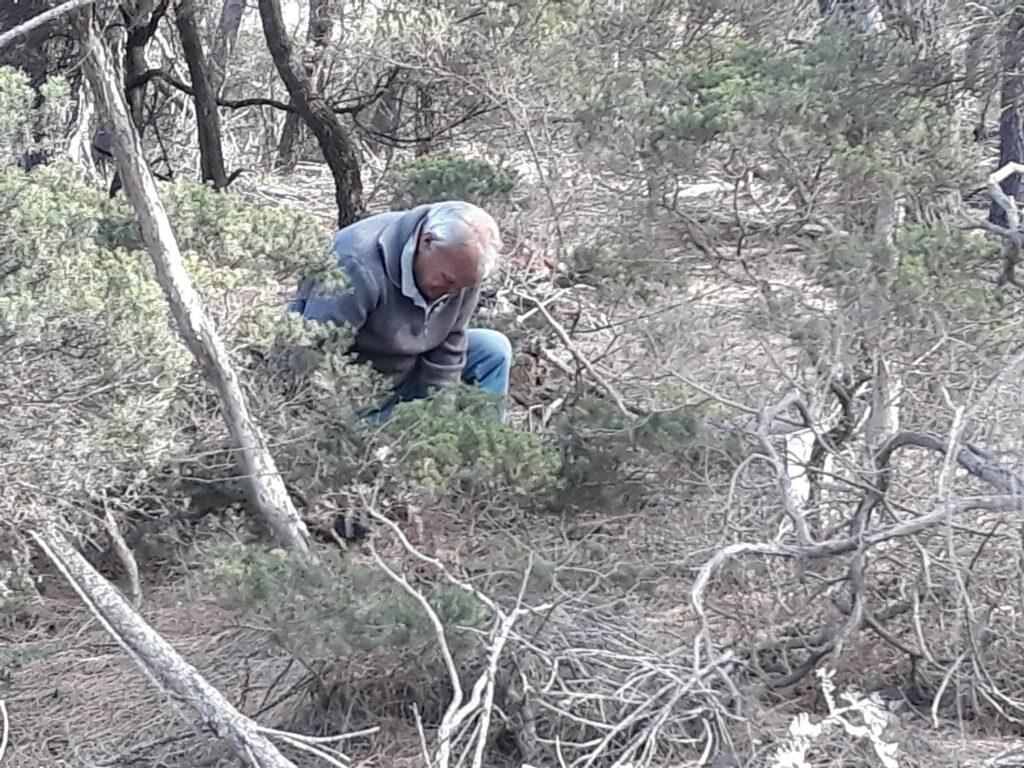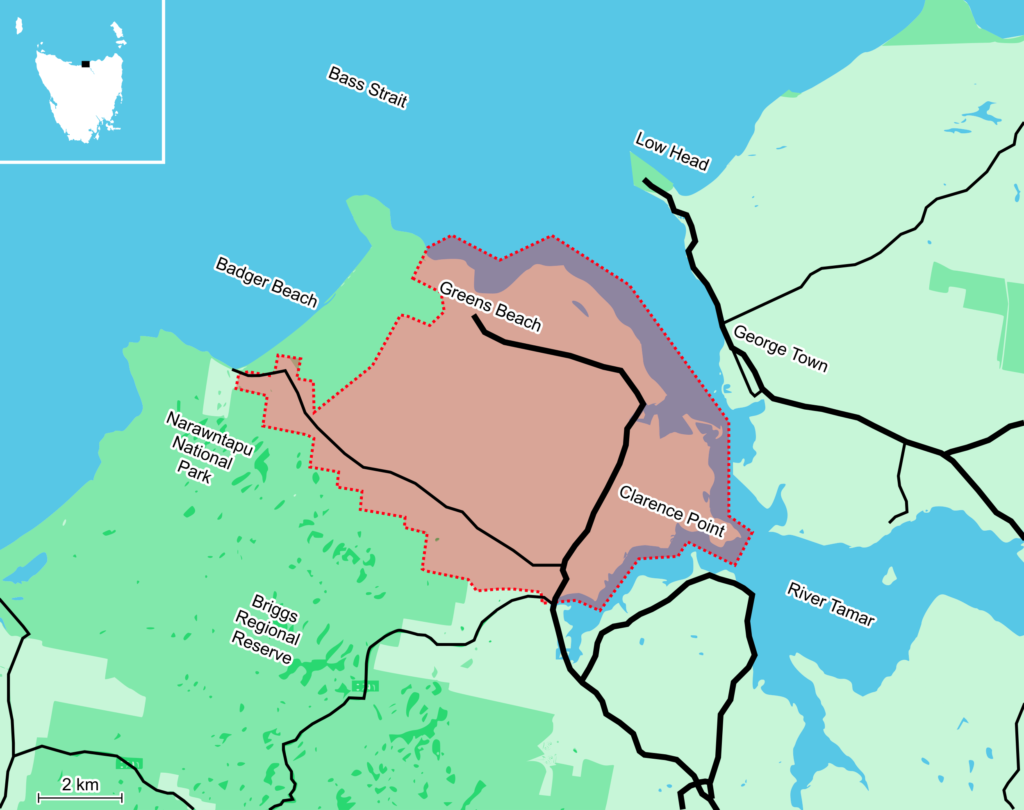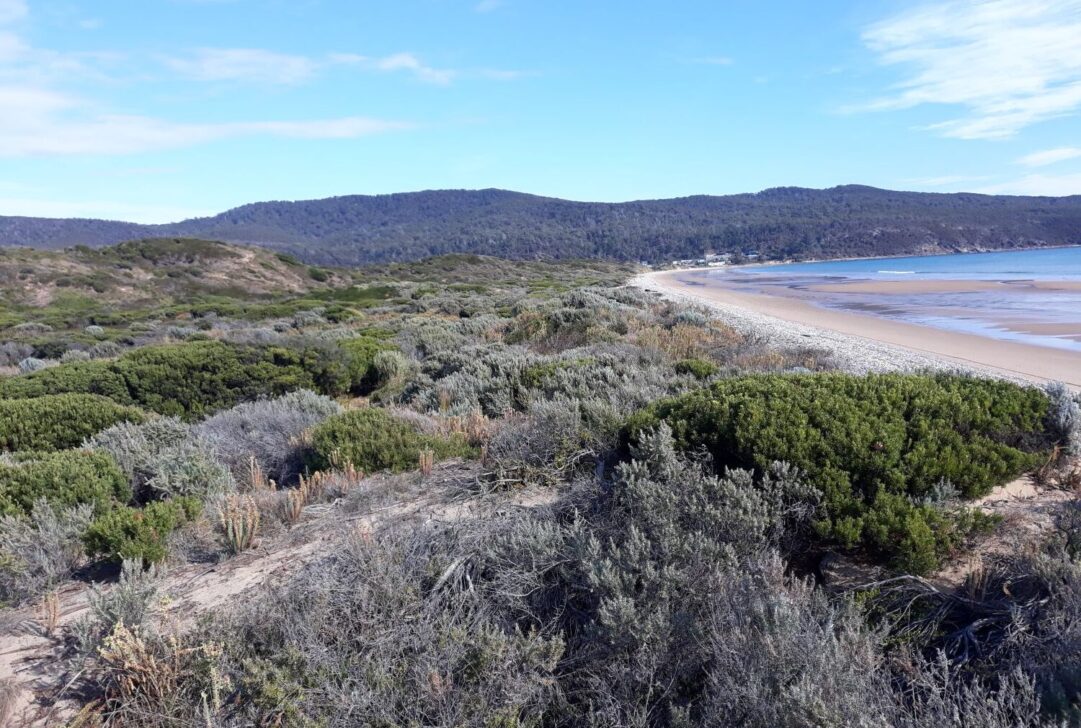The Lower West Tamar region is a striking landscape of coastal reserves, forested national park, fertile farmland and small townships. Located at the mouth of Tasmania’s kanamaluka/Tamar Estuary, the area is a haven for biodiversity, providing critical habitats for threatened species such as the hooded plover, eastern barred bandicoot, spotted-tailed quoll, and the iconic Tasmanian devil. This mix of rugged coastline and lush vegetation is a vital ecological corridor, offering both refuge for native wildlife and opportunities for local communities to engage in conservation. However, the region’s biodiversity faces significant threats from invasive predators like feral cats, which have a devastating impact on native species and local agriculture. These threats prompted the launch of the Lower West Tamar Cat Management Project in 2019.
About the Lower West Tamar Cat Management Project
This community-led initiative tackles the impacts of feral and stray cats in Tasmania’s Kelso, Greens Beach, and Clarence Point areas. The project area spans 6,500 hectares at the mouth of the kanamaluka/Tamar Estuary and is bordered by coastline and national park forests.
These natural barriers help reduce the migration of feral cats from surrounding areas, making the Lower West Tamar a strategically viable location for feral cat management. Spearheaded by the West Tamar Landcare Group and the Northern Area Advisory Group, the project received initial funding from the Federal government’s Communities Environment Program, and then from the West Tamar Council. This lays the foundation for an ongoing conservation effort. From the outset, a project plan was developed to employ a multi-pronged program approach, integrating responsible pet ownership campaigns, community engagement, and a carefully coordinated feral cat cage trapping program.

Cat trapping work in the landscape.
Cat trapping work in the landscape.
Community engagement is a cornerstone of the project’s approach
Community engagement is vital: the project committee works tirelessly to keep residents informed and involved, leveraging partnerships with organisations such as the RSPCA, NRM North, Landcare Tasmania, and Cradle Coast NRM. Collaborations provide valuable resources, training, and advice, helping to ensure the project’s success.
Education and outreach are vital components in gaining community support and reducing the chance of trapping pet cats. Public meetings, held in 2019-2020, introduced residents to the project’s goals and methods. Subsequent newsletters, flyers, and social media updates ensure ongoing communication. A key part of this effort encouraged residents to desex and microchip their pet cats – requirements of the Cat Management Act 2009 – as well as contain their pets to their properties. To support this, the project offered financial incentives for veterinary services. Uptake was lower than expected as many pet owners had already desexed their cats or chose to pay for it themselves. A microchipping day, organised in collaboration with the West Tamar Council, provided free microchipping to 40 pet cats, further demonstrating the community’s commitment to responsible pet ownership.
Feral cat management techniques
Cage trapping is the main feral cat management technique used in the program, as this, along with the use of a firearm, are the only tools available to the group under state legislation. But the journey to effective implementation was not without challenges, with the group learning from their setbacks. Initial efforts in July 2020 relied on volunteers using collapsible traps. These proved unsuitable, as larger feral cats often escaped, and the traps posed risks to non-target species such as Tasmanian devils.
Recognising the need for more robust equipment and training in best practice trapping techniques, the project engaged John Bowden, an experienced contract trapper. John provided a recommendation for Australian-made traps designed for durability and safety. The improved traps, paired with training in trap placement, set up, and trap baiting (including the need to keep baits fresh), significantly increased trapping success. By 2024, over five trapping seasons, the project had removed 100 feral cats, with only 13 domestic cats identified and safely released. This careful and humane approach ensured compliance with the Cat Management Act 2009 and the National Standard Operating Procedure: Trapping of feral cats using cage traps.
The program’s success also depends on its ability to adapt and refine its methods over time. Trapping seasons are scheduled during late autumn and early winter when prey scarcity increased the likelihood of success, and risks to lactating females are minimised. Volunteers and contractors collaborate closely, with continued training provided to ensure humane and effective trapping practices. The inclusion of professional expertise not only enhances capture rates but also builds the confidence and skills of local volunteers.

A map of the West Tamar Landcare Feral Cat Control Program’s area of operation.
A map of the West Tamar Landcare Feral Cat Control Program’s area of operation.
The ecological benefits of the project have already been noticed
Healthy populations of native species, including Tasmanian devils, spotted-tailed quolls, bandicoots, potoroos, and shorebirds are now frequently observed in the project area, with trappers reporting these animals in good health and of varying ages and sexes. Quantitative monitoring of native animals has not yet been performed, but anecdotal evidence from residents highlighted increased sightings of bandicoot diggings, juvenile birds, and other wildlife, suggesting a resurgence of native fauna. Local farmers are also reporting reduced losses of lambs through toxoplasmosis, suggesting less cat activity on their farms. These changes demonstrate the benefits of reducing feral cat populations.
Early-stage wildlife monitoring by the Tasmanian Land Conservancy and NRM North provided baseline data on native fauna, which informed the project plan and trap site selection. All trap captures are recorded, including species, age, sex and condition, giving an idea of feral cat numbers and structure over time. By 2024, the group recognised the need for more official monitoring of program outcomes and acquired some funding to invest in motion cameras to identify hotspots for feral cat activity and assess the effectiveness of management strategies. These tools will be used to provide insights into whether the program’s aims are being met, improve efficiency and modify activities if needed.
The project’s achievements have been made possible through substantial contributions from volunteers, whose donated time and efforts have been conservatively valued at over $25,000. Additionally, after the initial grant from the Federal government’s Communities Environment Program, the West Tamar Council has provided ongoing seed funding and in-kind support, including printing and distributing newsletters, organising microchipping events, and offering logistical assistance. These partnerships have been instrumental in sustaining the project and building a foundation for long-term success.
The project has faced challenges as well as successes
Along with successes, the project has faced several challenges, particularly in managing community concerns. Despite carefully designing the program to minimise the potential for trapping pets or strays, a small number of residents opposed the trapping program, citing fears for their pets or desires to domesticate stray cats. Some committee members have faced verbal abuse and, in one case, physical assault. Traps have also been tampered with, when locations were made public at the time of trapping. These incidents are rare but underscored to the group the importance of a good written project plan that allowed for clear communication at the right time, transparency, and consistent messaging about the project’s goals and methods including that traps were not being laid in the towns. This has meant that community support far outweighs opposition.

John Bowden gives a feral cat trapping demonstration.
John Bowden gives a feral cat trapping demonstration to community members.
What’s next for the project?
Looking ahead, the Lower West Tamar Cat Management Project aims to expand its monitoring efforts and refine its strategies to further reduce feral cat populations and support native wildlife recovery. The project committee plans to use motion cameras more extensively to identify new trapping hotspots and reduce efforts in low-activity areas. Continued collaboration with local, state, and federal agencies will be critical to securing additional funding and ensuring the initiative’s longevity.
This project demonstrates the power of community-led conservation. Through a combination of a good plan, a suitable site, utilising available techniques to their full advantage, expert help and training, adaptive management, and strong partnerships, the Lower West Tamar Cat Management Project has helped protect Tasmania’s unique biodiversity in the lower kanamaluka/Tamar. While challenges remain, the project’s success offers a model for other groups wanting to tackle similar issues, showcasing how local action can drive meaningful change in preserving Australia’s natural heritage.
Key learnings for the group:
- A small group of dedicated people can make a big difference
- A skilled steering committee of different stakeholders was essential to develop and deliver the project
- Community engagement and support is needed, especially so close to urban areas
- A project plan, written down, is invaluable for both directing activities and communicating with the public and other stakeholders
- Transparency is key to community support
- Proper training, or engaging a skilled practitioner, is key to trapping success
- Bait needs to be regularly replaced; feral cats don’t like mouldy old bait
- Even with volunteer support, and low costs, ongoing funding is vital to purchase new equipment, materials, training, communication and incidentals.
Feral and domestic cat management has been increasing in Tasmania in recent years. As a peak body, Landcare Tasmania, with assistance of the NFCFMC, has been a driving force behind cat management efforts across the state, as member groups interested in tackling the significant threats posed by feral and stray cats to Tasmania’s biodiversity and agricultural industries increases. By providing workshops, educational resources, grants, a lending library of cage traps, motion cameras and microchip scanners, as well as fostering partnerships, Landcare Tasmania helps local organisations and landholders implement effective, humane strategies for cat management. Their work promotes best practices in trapping, containment, and responsible pet ownership, while also raising awareness of the ecological and economic impacts of invasive predators. With the support of Landcare Tasmania and groups like West Tamar Landcare, cat management in Tasmania is gaining momentum, creating meaningful improvements for native wildlife and farming communities alike.
Chat with your state Landcare body, or local Landcare group, to find out if there is a program you can get involved with to manage feral cats in your area.
Information in this section was obtained from West Tamar Landcare and Landcare Tasmania [1, 2, 3].














